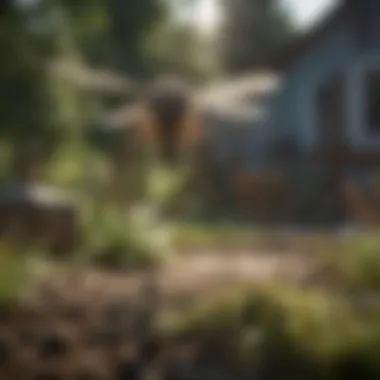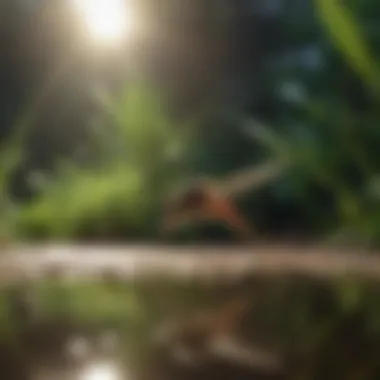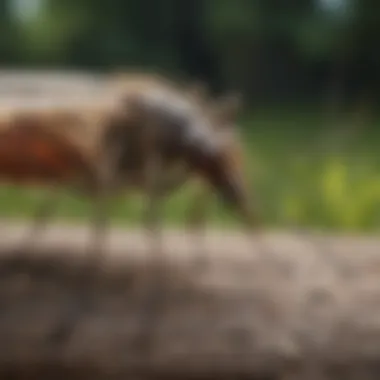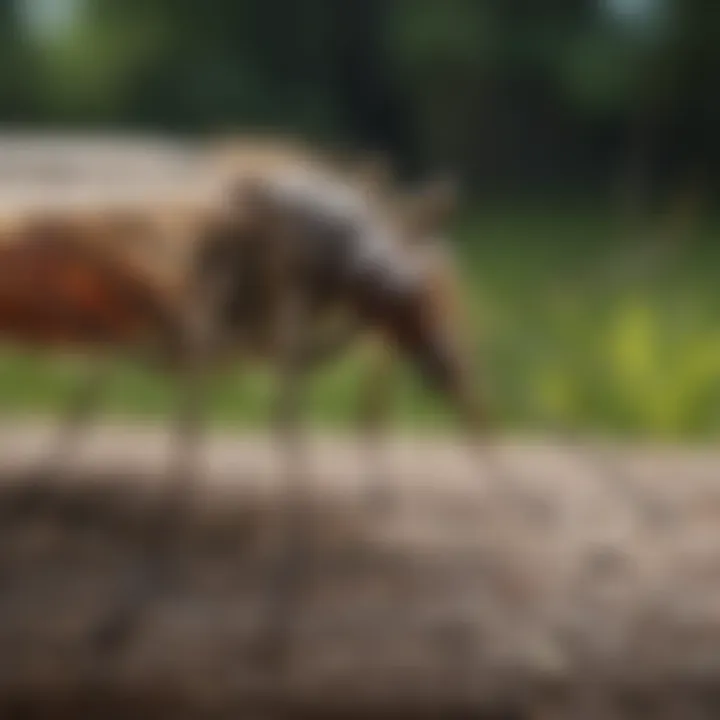Effective Strategies for Mosquito Control in Yards


Intro
Mosquitoes are not simply an annoyance in residential yards; they pose real health risks and can disrupt outdoor activities. Understanding their behaviors and breeding patterns is crucial for effective control. This article aims to provide homeowners, particularly housewives and house owners, with insightful strategies to combat mosquito invasions while maintaining a balance with nature.
In this guide, we will explore several key areas, including the identification of these pests, prevention techniques, and eco-friendly control solutions. By the end of this article, you will have a clearer understanding of how to reduce mosquito populations effectively within your outdoor spaces, enhancing your enjoyment of your yard without invasive chemicals.
Understanding Pests
Definition of Pests
Pests are organisms that cause harm to human activities, particularly when it comes to agriculture or health. Mosquitoes are classified as pests due to their ability to spread diseases such as malaria, dengue fever, and Zika virus. Their bites not only cause discomfort but can also lead to serious health issues in some instances.
Importance of Pest Identification
Identifying mosquitoes can be a critical first step in control. Recognizing the species is vital, as habits and breeding patterns vary. For example, species like Aedes aegypti breed in stagnant water and are more active during the day, while Culex pipiens prefer breeding sites with organic matter. Being aware of these differences can help tailor your control strategies effectively.
Prevention Techniques
Home and Garden Preventative Measures
A proactive approach to mosquito control should start in your backyard. Here are some fundamental measures you can take:
- Eliminate Standing Water: Regularly check for and remove any water that collects in items like bird baths, flowerpots, or tires.
- Maintain Your Yard: Trim bushes and mow grass to reduce resting areas for adult mosquitoes. Clearing debris also limits potential breeding sites.
- Install Screens: Ensure windows and doors have screens without holes, keeping mosquitoes outside where they belong.
Seasonal Prevention Tips
Preventive actions should adapt to seasonal changes. Early in the spring, inspect your yard for signs of stagnant water. As temperatures rise in summer, consider scheduling regular checks and clean-ups.
Eco-Friendly Pest Control Solutions
Overview of Sustainable Practices
Using sustainable methods can significantly reduce the reliance on harmful chemicals. There are various organic methods to help control mosquitoes effectively:
- Attract Natural Predators: Encourage birds and bats in your yard, as they naturally feed on mosquitoes.
- Companion Planting: Some plants, like lavender and marigolds, repel mosquitoes due to their distinct scents.
Natural Remedies and Their Effectiveness
Several natural remedies can provide limited but effective relief:
- Essential Oils: Oils like citronella, eucalyptus, and tea tree oil can deter mosquito bites when applied topically or used in diffusers.
- Garlic Spray: Mixing garlic with water creates a bitter spray that mosquitoes find unappealing. While the odor may be strong for humans, it is generally safe and can keep pests at bay.
By integrating these eco-friendly practices, you contribute to a healthier environment while managing pest populations.
By adopting both preventive measures and sustainable control methods, homeowners can cultivate a more enjoyable outdoor environment that minimizes mosquito nuisances. Understanding pests and employing practical strategies is critical in this endeavor.
Understanding Mosquito Behavior
Comprehending the behavior of mosquitoes is crucial for effective control strategies. Knowing how mosquitoes live and reproduce helps in targeting specific stages in their life cycle. This knowledge lays the groundwork for relevant preventive measures and effective response techniques.
Life Cycle of Mosquitoes
The life cycle of mosquitoes consists of four distinct stages: egg, larval, pupal, and adult. Each stage presents unique challenges and opportunities for intervention. By interrupting any stage, homeowners can reduce mosquito populations significantly.
Egg Stage
The egg stage is the first and foundational step in the mosquito’s life cycle. Mosquitoes typically lay their eggs on or near water surfaces. This choice is critical as the eggs require moisture to develop into larvae. A notable characteristic of this stage is that some species can lay eggs that can survive prolonged dry periods, making them resilient. Understanding this feature aids in developing strategies to reduce mosquito emergence from eggs after heavy rains.
Advantages of targeting the egg stage include minimizing the population at the source. This proactive step often requires little more than managing water sources in the yard.
Larval Stage
During the larval stage, mosquito larvae emerge in aquatic environments. This period is where they grow and feed on organic matter and algae. This stage is a prime opportunity for control since larvae are mostly stationary, making effective treatments possible. A key characteristic is their reliance on standing water, a factor that builds the case for regular inspection and management of potential ponds in the yard.
Advantages include the effectiveness of larvicides during this stage. This approach can sharply cut down emerging adult populations. However, care must be taken regarding environmental impact when applying chemical controls.
Pupal Stage
The pupal stage is where the mosquito undergoes transformation before becoming an adult. This stage is often referred to as the resting stage. Larvae create a protective skin around themselves, making them slightly less vulnerable to certain controls. A unique feature of this phase is that pupae do not feed; rather, they are awaiting a change into adulthood.
The pupal stage represents a more challenging target for control methods. They are less active, which means that time is essential. Strategic timing of control methods can be vital in this stage since they can emerge as adults within a day or two.
Adult Stage
In the adult stage, mosquitoes are fully developed, having wings and the ability to fly. They are particularly notable for their biting behavior, which is significant for transmitting diseases. Adults emerge from the pupal stage, usually seeking sources of food for sustenance. A key characteristic of this stage is their attraction to humans and animals due to factors like carbon dioxide and body heat.
Controlling adult mosquitoes presents the greatest challenge. They can migrate over significant distances easily, so local yard treatments might not suffice. Understanding this stage guides the need for broader community approaches in mosquito management.
Attractants and Repellents
Understanding what attracts or repels mosquitoes can provide homeowners with powerful tools for controlling their populations.
Carbon Dioxide


Carbon dioxide is a significant attractant for mosquitoes. They are drawn to areas with higher concentrations of carbon dioxide, making it vital to manage your breathing when outside. This characteristic is particularly notable at night, when mosquitoes tend to hunt for food more actively.
While individuals cannot eliminate carbon dioxide entirely, strategies can be enacted such as avoiding strongly scented products, which can mask the smell of CO2, possibly reducing attraction to mosquitoes.
Body Heat
Mosquitoes find warmth attractive. Body heat signals to mosquitoes that a potential host is nearby. This connection makes wearing lighter clothing and maintaining cool body temperatures can be a practical consideration. The presence of heat indicates high blood flow, which mosquitoes seek out.
Adults can leverage this understanding of heat attraction by adapting outdoor activities to cooler times of the day or by using fans that create a breeze, disrupting mosquitoes’ ability to detect heat sources.
Odors and Fragrances
Certain odors are known to attract or repel mosquitoes. This includes natural body odors, perfumes, and scented lotions. Key takeaways include recognizing that floral or sweet scents may attract mosquitoes, while citrus or herbal scents like citronella may repel them.
Being mindful of the fragrances used while enjoying outdoor spaces can be a simple yet effective measure against mosquitoes.
Mosquito control begins with understanding their patterns and preferences. Knowing their behavior equips you to make informed decisions in your yard.
Preventive Measures for Mosquito Control
Preventive measures play a crucial role in controlling mosquito populations in your yard. Understanding these strategies helps minimize the risk of disease transmission associated with mosquitoes. Effective preventive measures can also enhance the comfort level of outdoor spaces. By implementing specific actions, homeowners can create a less inviting environment for mosquitoes, which ultimately leads to reduced annoyance and health risks.
Eliminating Standing Water
Importance of Drainage
Drainage is vital in preventing mosquitoes from breeding. Standing water serves as an ideal breeding ground for these pests, so ensuring proper drainage is essential. When water collects in ponds, old tires, or clogged gutters, it creates a perfect habitat for mosquito larvae. Cultivating proper drainage reduces these areas of standing water.
Homeowners should assess their properties for potential drainage issues. A key characteristic of effective drainage is its ability to quickly allow water to flow away from yards. This strategy is beneficial since it not only limits mosquito breeding sites but also contributes to overall yard health by preventing mold and mildew growth.
A unique feature of drainage systems often discussed is the role of landscape grading. Proper grading directs water flow away from the foundation, which can also aid in mosquito control. Implementing these practices results in cleaner, healthier outdoor living environments.
Common Water Accumulation Areas
Various areas around homes can tend to collect water, making them hotspots for mosquitoes. These common water accumulation areas include clogged gutters, bird baths, and unused swimming pools. Identifying and addressing these spots is crucial for effective mosquito control.
A significant characteristic of these areas is their ability to hold water for extended periods. Often, homeowners overlook these spots, so solutions and awareness are necessary. Regular cleaning and maintenance can contribute greatly to reducing mosquito populations.
One noted advantage of addressing water accumulation is the enhanced aesthetics of the yard. By removing stagnant water, the yard appears tidier, which improves the overall enjoyment of outdoor spaces.
Seasonal Considerations
Seasonal variations also play a role in mosquito control efforts. Understanding the behavior of mosquitoes during different seasons can dictate preventive actions. In warmer months, mosquitoes become more active and reproduce rapidly.
A key aspect of seasonal considerations is timing. Homeowners can prepare their yards for summer before the season starts. This proactive approach often results in more effective management of mosquito threats. Unique features to consider include the regional climate and its impact on breeding cycles.
While addressing seasonal factors can require extra effort, the advantages include a more enjoyable outdoor space and less risk of mosquito-borne illnesses.
Landscape Management
Choosing Mosquito-Repellent Plants
Selecting mosquito-repelling plants is a strategic aspect of landscape management. Some plants, such as citronella and marigolds, emit odors that mosquitoes find distasteful. Introducing these plants into your garden can naturally deter these pests.
A key characteristic of these plants is their natural repellent properties, which benefit homeowners seeking chemical-free alternatives. Additionally, they provide aesthetic value and enhance the overall look of the yard.
The unique feature of planting mosquito-repellent flora is their role in creating a more pleasant outdoor environment. With both functional and decorative attributes, these plants are a favorable choice for anyone looking to manage mosquito presence effectively.
Mowing and Yard Maintenance
Regular mowing and maintenance play a significant role in mosquito control. Tall grass and overgrown shrubbery provide places for mosquitoes to hide and breed. Maintaining your lawn by regularly cutting grass to an appropriate height can reduce these habitats.
The key characteristic of a well-manicured yard is its lack of dense, unkempt areas, which can harbor pests. A neat yard contributes to both mosquito control and a more inviting atmosphere for family gatherings.
Unique to this practice is the dual purpose that yard maintenance serves—enhancing the landscape while reducing mosquito hiding spots. Mowing is thus both an aesthetic and practical choice when managing mosquitoes.
Designing Your Outdoor Space
The design of your outdoor space can also impact mosquito populations. Specific layouts can discourage mosquito presence while promoting enjoyment in outdoor areas. By incorporating hardscapes, such as patios or pathways, you create environments that do not encourage mosquito breeding.
A characteristic of thoughtful design is the strategic placement of features. For example, incorporating open spaces allows more airflow, making it less likely for mosquitoes to linger. Planning can be a beneficial approach when it comes to managing these pests.
Unique design elements might also include the use of lighting, such as LED fixtures that do not attract mosquitoes. This consideration adds significant value to any outdoor area by promoting usability while effectively managing pests.
Natural Solutions to Repel Mosquitoes
Natural solutions have gained increased attention in mosquito control strategies. These methods offer a more environmentally friendly approach, aligning with the growing desire for sustainable pest management. Utilizing natural repellents can mitigate the reliance on chemical products, potentially enhancing safety for families and pets while still providing effective protection from mosquitoes.
Essential Oils as Repellents
Essential oils serve as potent repellents against mosquitoes. Many homeowners find these substances appealing due to their natural origin and fragrance. Their effectiveness often depends on the specific type of oil used.
Lemon Eucalyptus Oil
Lemon Eucalyptus Oil is notable for its mosquito-repelling properties. It contains a compound known as PMD, which has been shown to provide similar protection as DEET. This characteristic makes Lemon Eucalyptus Oil a popular choice for natural mosquito control. Additionally, it has a pleasant scent, which many users enjoy. However, it is worth noting that the oil can cause skin irritation for some individuals.


Lavender Oil
Lavender Oil is well-regarded for its calming aroma, but it also repels mosquitoes. Its unique fragrance can deter these pests while simultaneously providing a soothing environment for humans. The appeal of Lavender Oil lies in its dual function. However, its effectiveness may vary, and some might find that it requires more frequent application.
Tea Tree Oil
Tea Tree Oil stands out due to its strong antiseptic properties and ability to repel mosquitoes. Known for its broad antibacterial benefits, it simultaneously protects against mosquito bites. It can be combined with carrier oils for safer application on the skin. Despite its advantages, Tea Tree Oil may cause allergic reactions in some users, which requires caution.
DIY Repellent Recipes
Creating your own mosquito repellents can be effective and cost-efficient. DIY recipes allow for control over the ingredients, ensuring a natural approach while reducing exposure to synthetic chemicals.
Sprays and Lotions
Sprays and lotions can incorporate various essential oils to create effective natural repellents. These mixtures appeal to those who prefer customized solutions. The convenience of sprays makes application easier. Users often appreciate the ability to adjust the scent and strength. However, they might require reapplication throughout the day to maintain effectiveness.
Natural Candles
Natural candles present another avenue for repelling mosquitoes. Made with essential oils, they release scents that deter these pests while also contributing to an inviting atmosphere. The burning process can enhance oil diffusion in outdoor spaces. Nevertheless, the coverage area is limited compared to sprays, requiring strategic placement around patios or gardens.
Cloth Use
Using cloths infused with essential oils can serve as a portable method to keep mosquitoes at bay. This strategy allows individuals to carry protection with them when outside. Certain fabrics can retain the scent for extended durations, providing a longer-lasting benefit. The downside is that it may not offer as strong protection as sprays or candles and may require frequent renewal of the scent.
Engaging with natural solutions can offer an effective pathway to enhance your outdoor experience, while maintaining an environmentally friendly approach to mosquito control.
Chemical Solutions for Mosquito Control
Chemical solutions are essential for effective mosquito management in residential areas. These options are often relied upon to quickly eliminate mosquito populations and provide immediate relief to homeowners. Understanding the various chemical solutions available can make a significant difference in how effectively these pests are controlled. Homeowners should consider both immediate effectiveness and long-term impacts when selecting their methods.
Understanding Insecticides
Insecticides play a crucial role in mosquito control. They are designed to kill or inhibit pests like mosquitoes, reducing their presence in outdoor spaces.
Types of Insecticides
The types of insecticides can be categorized into several key groups—pyrethroids, organophosphates, and natural insecticides. Pyrethroids are synthetic chemicals based on pyrethrins, which are derived from chrysanthemum flowers. They are popular due to their effectiveness and relatively low toxicity to humans and pets.
Organophosphates are another class, offering powerful results but come with increased safety concerns. They function by disrupting the nervous system of insects. On the other hand, natural insecticides, such as those from neem oil, are favored by environmentally conscious individuals. They tend to break down quicker in the environment, having less long-term impact.
Each type has its unique features, making them preferred choices depending on the situation and user preferences. For example, pyrethroids might be effective against adult mosquitoes but are less so for larvae. Understanding these differences helps in selecting the right product for specific needs.
Application Methods
Application methods significantly affect how well insecticides work. Spraying, fogging, and granular methods are commonly used. Spraying involves using a liquid solution directly targeted at areas where mosquitoes gather. This method allows for immediate results and is often performed in areas like backyards or gardens.
Fogging is another method that disperses the insecticide in a fine mist, covering larger areas quickly. This is especially effective in treating extensive mosquito issues. Granular applications are useful for targeting larvae and can be spread around plants or water bodies.
The choice of method depends on the severity of the mosquito issue, the area being treated, and local environmental considerations.
Safety Precautions
Using insecticides requires careful safety precautions. Proper handling and application significantly reduce risks to humans, pets, and the surrounding environment. Always read and follow label instructions for safe usage.
Wearing protective gear, such as gloves and masks, is recommended. Ensuring that children and pets are kept away during application can prevent exposure. Additionally, considering the timing of application can make a difference. For instance, applying insecticides during calm weather can prevent drift to areas where they may cause harm.
Taking these precautions not only ensures personal safety but helps to maintain ecological balance in the treated areas.
Professional Pest Control Services
Engaging professional pest control services can often provide a comprehensive solution to mosquito management. These experts bring specialized know-how and customized plans addressing specific property needs.
Assessing Your Needs
The initial step in accessing professional help is assessing personal needs and concerns regarding mosquito infestations. This may involve taking a close look at the yard, identifying problem spots, and understanding how active mosquito populations are.
By clearly outlining issues, pest control services can better tailor their solutions. This customization is beneficial because not all properties have the same mosquito challenges, depending on factors like landscape and water presence.
Choosing a Service
Choosing the right pest control service is vital. It's best to consider their reputation, effectiveness, and customer feedback. Reviews and testimonials can provide insight into their success rates. Also, confirming their licenses and certifications ensures they follow industry standards and safety regulations.
Many services offer free consultations, allowing homeowners to discuss concerns and expected outcomes before beginning work.
Cost Considerations
Cost considerations are always a key element when considering professional services. While it may seem expensive upfront, investing in quality pest control can save money in the long run by reducing mosquito populations effectively and preventing potential health risks associated with bites.
Comparing quotes from different services provides a clearer understanding of the offerings and allows homeowners to make informed decisions that suit their budgets. Ultimately, weighing costs against the benefits can guide the investment in professional mosquito control solutions.
Technology and Mosquito Control
The integration of technology in mosquito control has become increasingly significant. This advancement allows for more effective and targeted approaches, as well as offering convenient solutions for homeowners. In an era where effective pest management is essential, technology provides tools and strategies that help minimize the presence of mosquitoes in residential areas. These methods not only offer immediate results but can also contribute to long-term control when implemented properly.


Using Mosquito Traps
Types of Traps
There are several types of mosquito traps available to consumers, each designed to attract and kill mosquitoes efficiently. Electric traps, for example, use ultraviolet light to lure mosquitoes and then eliminate them using a zapper mechanism. Other traps use attractants like carbon dioxide to mimic human presence, drawing mosquitoes in before trapping them. These traps are popular choices because they reduce the mosquito population without requiring harmful chemicals. However, their effectiveness can be influenced by environmental factors such as placement and nearby attractants.
Effective Placement
The placement of mosquito traps is crucial for their effectiveness. Traps should be situated in shaded areas away from human activity. This strategy attracts mosquitoes who prefer to rest in cooler spots. In addition, it's beneficial to place traps near water sources, where mosquitoes breed. Proper placement not only increases capture rates but also minimizes interactions between people and traps. However, homeowners must consider the possibility of traps drawing mosquitoes closer to their living areas if poorly placed.
Maintenance
Regular maintenance of mosquito traps is essential to maximize their efficiency. Homeowners should clean traps periodically to ensure they are free from debris that could reduce their effectiveness. Checking the traps for captured mosquitoes also ensures that they are functioning correctly. A clean trap provides optimal attraction without chemical odors or residues. However, a downside may be that maintenance requires consistent effort and can be labor-intensive for some homeowners.
Ultrasonic Devices
Mechanism of Action
Ultrasonic devices claim to repel mosquitoes through high-frequency sound waves that are inaudible to humans. The idea is that these sound waves disrupt the hearing of mosquitoes, making it difficult for them to locate hosts. This mechanism is unique among other mosquito control options, relying on sound rather than physical barriers or chemical action. However, scientific evidence supporting the effectiveness of these devices is still inconclusive, which leads some to be skeptical of their claims.
Effectiveness
The effectiveness of ultrasonic devices in repelling mosquitoes has been met with mixed reviews. Some users report a noticeable decrease in mosquito activity, while others observe little to no change. This inconsistency may be attributed to various factors, such as the specific brand or the surrounding environment in which the device is used. As they provide a chemical-free option, they can be appealing for those looking to avoid pesticides, yet results are often varied.
User Experiences
Experiences from users of ultrasonic devices can vary significantly. Some homeowners appreciate the ease of use and the lack of chemical exposure, while others express disappointment due to ineffective repelling. There is anecdotal evidence suggesting that these devices might work better in some settings. However, given their mixed reviews, many users often supplement ultrasonic devices with other mosquito control methods for a more comprehensive strategy.
Long-Term Strategies for Mosquito Control
Long-term strategies for mosquito control are vital for homeowners seeking sustainable solutions. These strategies not only address immediate issues but also aim to reduce mosquito populations over time. By implementing long-lasting methods, residents can create a more enjoyable outdoor environment while contributing positively to the community.
Investing time and resources in these strategies ultimately reduces reliance on chemical treatments and enhances the natural balance of the ecosystem in residential areas.
Community Efforts
Neighborhood Collaboration
Neighborhood collaboration involves residents working together to address mosquito control effectively. This collective effort creates a unified approach, making it easier to tackle common concerns.
A key characteristic of neighborhood collaboration is shared knowledge. Homeowners can exchange experiences and solutions that have worked for them. This aspect is beneficial because it builds a support system among neighbors. Many consider this a popular choice as it fosters community spirit. A unique feature of this collaboration is the pooling of resources for larger community initiatives. These initiatives can lead to better results in mosquito control than individual efforts alone. However, the challenge lies in ensuring comprehensive participation from all homeowners in the area.
Social Awareness
Social awareness is crucial for educating the community about the importance of mosquito control. It involves raising awareness about mosquito breeding sites and effective prevention techniques.
A key aspect of this approach is the dissemination of information through local events or workshops. This creates a beneficial atmosphere where individuals can learn and share their experiences. Social awareness has a unique feature in that it can empower individuals to take initiative and participate actively in mosquito management efforts. However, the disadvantage can be that some residents may still ignore the information provided, leading to lapses in action.
Shared Responsibility
Shared responsibility refers to the understanding that everyone in the community plays a role in mosquito control. This principle encourages residents to take ownership of their properties.
The key characteristic here is the mutual commitment to maintaining clean and mosquito-free environments. This collaboration is highly beneficial as it promotes accountability among neighbors. A unique feature of this principle is that it can spark community-led efforts, making local governments more likely to support initiatives. On the downside, discrepancies in participation levels may result in uneven control across neighborhoods, undermining overall efforts.
Monitoring and Ongoing Maintenance
Regular Inspection
Regular inspection of the yard and surrounding areas is critical for effective mosquito control. This involves identifying potential breeding sites and eliminating them proactively.
The key characteristic of regular inspections is their systematic approach. Homeowners can tackle problems before they escalate. This method is a beneficial choice as it fosters a culture of continuous upkeep. A unique feature of this strategy is that it allows for immediate actions to be taken, ensuring the environment remains as inhospitable as possible for mosquitoes. However, the downside is that inspections require commitment and diligence. Some homeowners might neglect this process over time.
Seasonal Adaptations
Seasonal adaptations focus on adjusting control methods based on the changing environment throughout the year. Awareness of seasonal patterns is key, as mosquito activity varies with weather changes.
A significant aspect of this approach is flexibility. Homeowners can tailor their strategies to align with seasonal needs, making it a beneficial choice. Seasonal adaptations often include using different repellents, traps, or preventive measures as required. A unique feature is that this strategy enhances responsiveness to ecological changes. The disadvantage may lie in the need for ongoing education about these adaptations, which can be a challenge for some residents.
Documentation of Findings
Documentation of findings entails keeping track of mosquito populations and treatment effectiveness. This approach allows homeowners to analyze what works best over time.
The key characteristic of documentation is its analytical nature. Homeowners can use this information to adjust strategies and make informed decisions. This method is well-regarded as it provides insights and progress tracking. A unique feature is the potential for sharing results within the community, fostering a collective knowledge base. However, the downside is that not all homeowners may find it easy to maintain consistent documentation, leading to gaps in data.
"Sustainable mosquito management requires an ongoing commitment to community collaboration, education, and diligent maintenance strategies."
End
In summary, it is crucial to understand the importance of controlling mosquito populations in residential areas. The conclusion of this article emphasizes a range of effective strategies that homeowners can implement. By addressing mosquitoes comprehensively, one can create a more pleasant outdoor environment.
The integration of both natural and chemical solutions comes to the forefront in the discussion about effective mosquito control. Homeowners should recognize the value of preventive measures such as eliminating standing water and maintaining their landscapes. These steps not only reduce mosquito breeding grounds but also enhance the overall aesthetics of yards.
Furthermore, long-term strategies involving community efforts highlight the collaborative approach needed for serious impact. Working together as neighbors can reinforce shared goals and responsibilities in tackling this nuisance. This cooperation can lead to an informed community, aware of the measures required throughout the mosquito season.
Ongoing maintenance and monitoring are emphasized as essential to sustaining these strategies. Regular inspections and seasonal adaptations ensure that the control measures remain effective over time.
In the end, understanding mosquito behavior is linked directly to the success of any mosquito control strategy. Homeowners who engage with the concepts laid out in this article could find themselves more equipped to combat these pests. In doing this, they also make strides towards providing safe and enjoyable outdoor spaces for family and friends.
Ultimately, effective mosquito control is a blend of knowledge, action, and community involvement, leading to enhanced quality of life at home.
This guide serves as a foundation for anyone aiming to minimize mosquito presence, thus contributing to a more harmonious and enjoyable yard.



